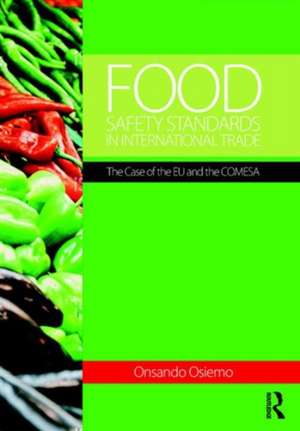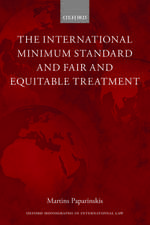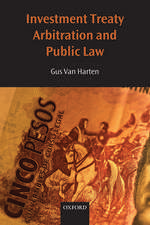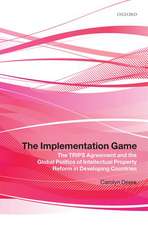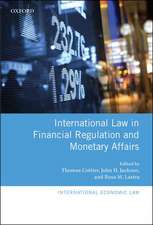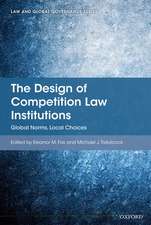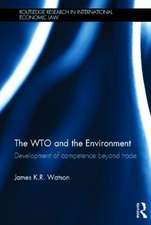Food Safety Standards in International Trade: The Case of the EU and the COMESA
Autor Onsando Osiemoen Limba Engleză Hardback – 19 sep 2016
| Toate formatele și edițiile | Preț | Express |
|---|---|---|
| Paperback (1) | 299.67 lei 6-8 săpt. | |
| Taylor & Francis – 8 iun 2018 | 299.67 lei 6-8 săpt. | |
| Hardback (1) | 849.11 lei 6-8 săpt. | |
| Taylor & Francis – 19 sep 2016 | 849.11 lei 6-8 săpt. |
Preț: 849.11 lei
Preț vechi: 1141.26 lei
-26% Nou
Puncte Express: 1274
Preț estimativ în valută:
162.52€ • 169.03$ • 136.19£
162.52€ • 169.03$ • 136.19£
Carte tipărită la comandă
Livrare economică 13-27 martie
Preluare comenzi: 021 569.72.76
Specificații
ISBN-13: 9781138694125
ISBN-10: 1138694126
Pagini: 250
Dimensiuni: 156 x 234 x 19 mm
Greutate: 0.53 kg
Ediția:1
Editura: Taylor & Francis
Colecția Routledge
Locul publicării:Oxford, United Kingdom
ISBN-10: 1138694126
Pagini: 250
Dimensiuni: 156 x 234 x 19 mm
Greutate: 0.53 kg
Ediția:1
Editura: Taylor & Francis
Colecția Routledge
Locul publicării:Oxford, United Kingdom
Public țintă
PostgraduateCuprins
Introduction
1 Introduction
2 Why SPS Standards?
3 Why the EU and the COMESA?
4 Objectives and scope
5 Plan of the book
Chapter 1. SPS Standards under the WTO SPS Agreement
1.1 Introduction
1.2 The significance of SPS standards
1.3 The WTO SPS Agreement
1.4 Harmonization of SPS standards
1.5 Provisions for Developing Countries under the SPS Agreement
1.6 Chapter discussion and conclusions
1.6.1 International SPS Standards and Harmonization
Chapter 2. EU Food Safety Standards
2.1 Introduction
2.2 Regulation 178 of 2002
2.3 The European food safety authority (EFSA)
2.4 A critical overview of the EU food safety policy and standards
2.5 Global administrative and constitutional law perspectives
2.6 Discussion and conclusions
Chapter 3. COMESA Food Safety Standards
3.1 Introduction
3.2 An overview of the COMESA
3.3 SPS Policies and Regulations in the COMESA
3.4 Chapter discussion and conclusions
Chapter 4. Case Studies in Food Safety Standards in EU-COMESA Trade
4.1 Introduction
4.2. The two schools of thought on the impact of food safety standards on trade
4.3 COMESA trade concerns with EU food safety regulations in beef, fishery and horticultural
products
4.4 Private voluntary standards (PVS) and EU food safety standards
4.5 Chapter discussion and conclusions
Chapter 5. Towards a Model for Co-operation in Food Safety Standardsin EU-COMESA Trade
5.1 Introduction
5.2 Tools for upgrading COMESA national food safety control systems
5.3 The COMESA food control system (CFCS)
5.4 Towards an EU-COMESA food control system
5.5 The EU-COMESA food control system (ECFCS)
5.6 Chapter discussion and conclusions
Chapter 6. Conclusions
6.1 Introduction
6.2 The SPS Agreement
6.3 EU food safety standards
6.4 COMESA food safety standards
6.5 A food control system for EU-COMESA food products trade
6.6 Final remarks
1 Introduction
2 Why SPS Standards?
3 Why the EU and the COMESA?
4 Objectives and scope
5 Plan of the book
Chapter 1. SPS Standards under the WTO SPS Agreement
1.1 Introduction
1.2 The significance of SPS standards
1.3 The WTO SPS Agreement
1.4 Harmonization of SPS standards
1.5 Provisions for Developing Countries under the SPS Agreement
1.6 Chapter discussion and conclusions
1.6.1 International SPS Standards and Harmonization
Chapter 2. EU Food Safety Standards
2.1 Introduction
2.2 Regulation 178 of 2002
2.3 The European food safety authority (EFSA)
2.4 A critical overview of the EU food safety policy and standards
2.5 Global administrative and constitutional law perspectives
2.6 Discussion and conclusions
Chapter 3. COMESA Food Safety Standards
3.1 Introduction
3.2 An overview of the COMESA
3.3 SPS Policies and Regulations in the COMESA
3.4 Chapter discussion and conclusions
Chapter 4. Case Studies in Food Safety Standards in EU-COMESA Trade
4.1 Introduction
4.2. The two schools of thought on the impact of food safety standards on trade
4.3 COMESA trade concerns with EU food safety regulations in beef, fishery and horticultural
products
4.4 Private voluntary standards (PVS) and EU food safety standards
4.5 Chapter discussion and conclusions
Chapter 5. Towards a Model for Co-operation in Food Safety Standardsin EU-COMESA Trade
5.1 Introduction
5.2 Tools for upgrading COMESA national food safety control systems
5.3 The COMESA food control system (CFCS)
5.4 Towards an EU-COMESA food control system
5.5 The EU-COMESA food control system (ECFCS)
5.6 Chapter discussion and conclusions
Chapter 6. Conclusions
6.1 Introduction
6.2 The SPS Agreement
6.3 EU food safety standards
6.4 COMESA food safety standards
6.5 A food control system for EU-COMESA food products trade
6.6 Final remarks
Notă biografică
Onsando Osiemo is a legal practitioner and researcher in Nairobi, Kenya. He obtained his PhD in law from the University of Amsterdam. His areas of research are in international trade law and regional integration in Europe and Africa.
Recenzii
'The author deftly exposes current problems with safety standards in food exports from Africa to Europe from a legal perspective, with sensitivity and insight. This book delivers original solutions to these important social challenges and is an invaluable resource for African and European policy makers, academics and the socially concerned.'
Dr Kamala Dawar, University of Sussex, UK
'Dr Osiemo has delivered an important and timely study of the comparable impacts of food safety standards in the context of regional trade arrangements: of particular note is his contribution to the debate about such standards in the context of Southern and Eastern Africa.'
Professor Mary Footer, University of Nottingham School of Law, UK
Dr Kamala Dawar, University of Sussex, UK
'Dr Osiemo has delivered an important and timely study of the comparable impacts of food safety standards in the context of regional trade arrangements: of particular note is his contribution to the debate about such standards in the context of Southern and Eastern Africa.'
Professor Mary Footer, University of Nottingham School of Law, UK
Descriere
Food safety has become a major concern for consumers in the developed world and Europe in particular. This has been highlighted by the recent spate of food scares ranging from the BSE (mad cow) crisis to Chinese melamine contamination of baby formula. To ensure food safety throughout Europe, stringent food safety standards have been put in place ‘from farm to fork’. At the same time, poor African countries in the COMESA rely on their food exports to the European market to achieve their development goals yet have difficulty meeting the EU food safety standards. This book examines the impact of EU food safety standards on food imports from COMESA countries. It also critically examines both EU and COMESA food safety standards in light of the WTO SPS Agreement and the jurisprudence of the WTO panels and Appellate Body. The book makes ground-breaking proposals on how the standards divide between the EU and the COMESA can be bridged and discusses the impact of EU food safety standards on food imports from poor African countries.
